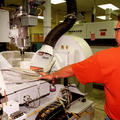
WIKIARCHIVES.SPACE
The Human Spaceflight Archive

Information
- Taken in
- Kennedy Space Center
- Author
- NASA
- Description
- In the Tile Fabrication Shop, Tony Rollins, with United Space Alliance, holds down a curtain while making a test sample of tile on a block 5-axis computerized numerical control milling machine. About 70 percent of a Space Shuttle orbiter's external surface is shielded from heat by a network of more than 24,000 tiles formed from a silica fiber compound. They are known as High-Temperature Reusable Surface Insulation (HRSI) tiles and Low-Temperature Reusable Surface Insulation (LRSI) tiles. Most HRSI tiles are 6 inches square, but may be as large as 12 inches in some areas, and 1 to 5 inches thick. LRSI tiles are generally 8 inches square, ranging from 0.2- to 1-inch thick. More advanced materials such as Flexible Insulation Blankets have replaced tiles on some upper surfaces of the orbiter.
- Created on
- Monday 10 August 1998
- Albums
-
Locations / OSM-4.915832801313164
US SPACE PROGRAM / SPACE SHUTTLE / MISSIONS / STS-95 / Rocket preparation
- Source link
- https://science.ksc.nasa.gov/gallery/photos/1998/captions/KSC-98PC-0929.html
- Visits
- 113
- Rating score
- no rate
- Rate this photo
- License
- CC BY-NC
- Modified by WikiArchives
- No (original)
- Downloads
- 0
Powered by Piwigo

